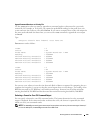
Glossary 193
Glossary
The following list defines or identifies technical terms,
abbreviations, and acronyms used in Dell
™
user documents.
A
Abbreviation for ampere(s).
AC
Abbreviation for alternating current.
AC power switch
A switch with two AC power inputs that provides AC power
redundancy by failing over to a standby AC input in the
event of a failure to the primary AC input.
access
Refers to the actions a user can take on a variable value.
Examples include read-only and read-write.
adapter card
An expansion card that plugs into an expansion-card
connector on the computer's system board. An adapter
card adds some specialized function to the computer
by providing an interface between the expansion bus
and a peripheral device. Examples of adapter cards
include network cards, sound cards, and SCSI adapters.
ADB
Abbreviation for assign database.
AGP
Abbreviation for accelerated graphics port. A high
performance graphics interface available for Intel
®
Pentium
®
Pro systems.
ASCII
Acronym for American Standard Code for Information
Interchange. A text file containing only characters from
the ASCII character set (usually created with a text
editor, such as Notepad in Microsoft
®
Windows
®
) is
called an ASCII file.
ASIC
Acronym for application-specific integrated circuit.
ASPI
Advanced SCSI programming interface.
ASR
Abbreviation for automatic system recovery. ASR consists
of those procedures that restore the system to running all
properly configured domains after one or more domains
have been rendered inactive due to software or hardware
failures or due to unacceptable environmental conditions.
asset tag code
An individual code assigned to a computer, usually by
a system administrator, for security or tracking purposes.
attribute
An attribute, or property, contains a specific piece of
information about a manageable component.
Attributes can be combined to form groups. If an
attribute is defined as read-write, it may be defined by
a management application.
authentication
The Server Administrator remote access controller has
two methods of authenticating user access:
RAC authentication and local operating system
authentication. RAC authentication is always enabled.
Administrators can set up specific user accounts and
passwords that allow access to the RAC.
Operating systems also require administrators to define
different levels of users and user accounts; each user
level has different privileges. Local operating system
authentication on the RAC is an option for
administrators who do not want define one set of
privileges for users in the operating system and a
separate set of users and accounts for the RAC. If you
enable local operating system authentication for the
RAC, you enable any user with Administrator status on
the operating system to log into the RAC.
autoexec.bat file
The
autoexec.bat
file is executed when you boot your
computer (after executing any commands in the
config.sys
file). This start-up file contains commands
that define the characteristics of each device connected
to your computer, and it finds and executes programs
stored in locations other than the active directory.


















